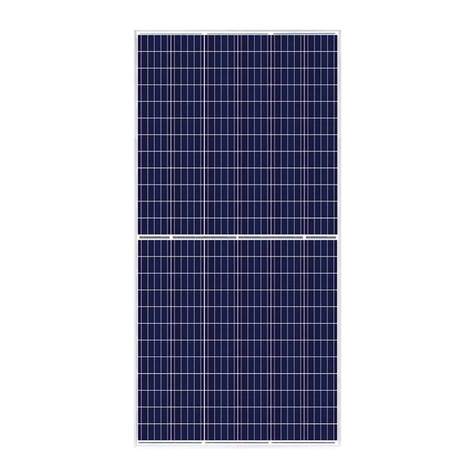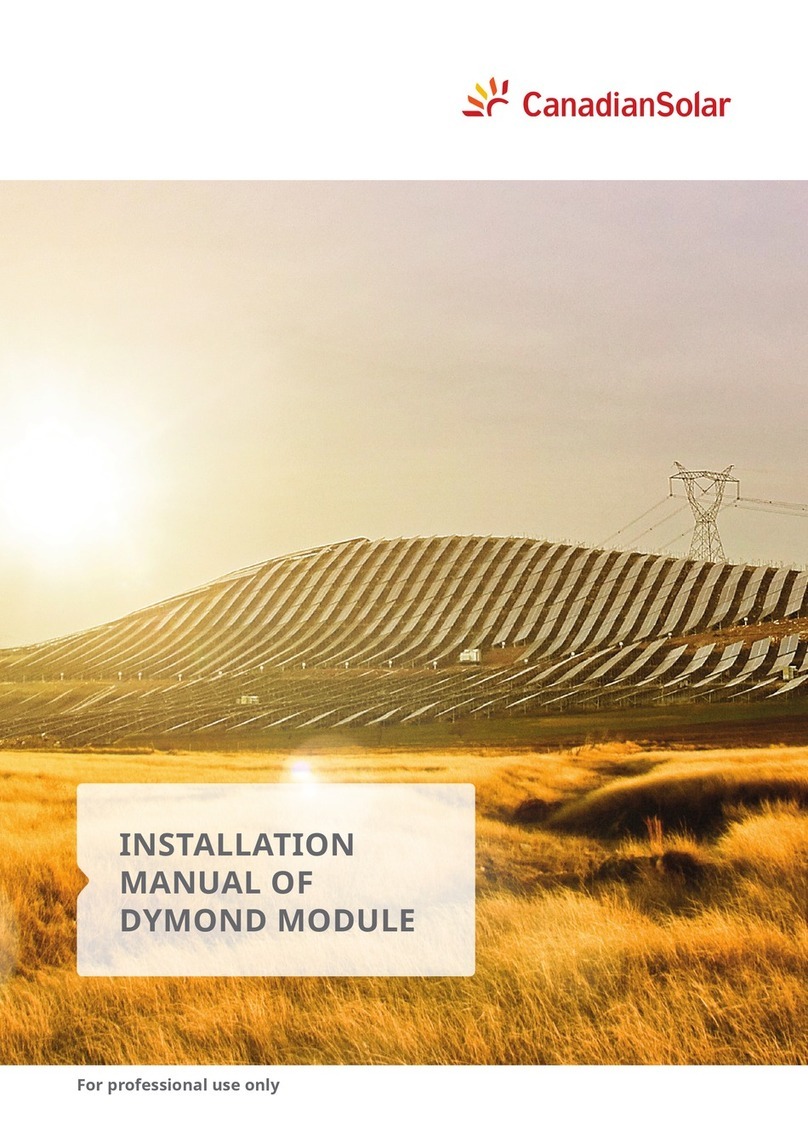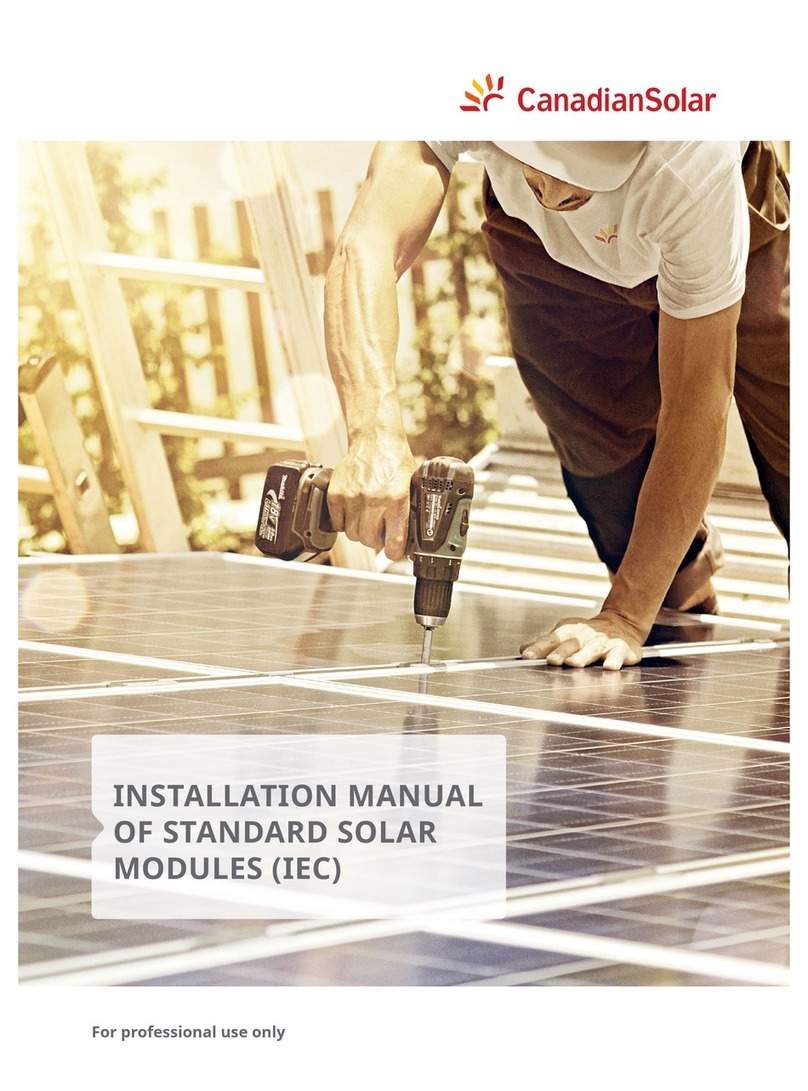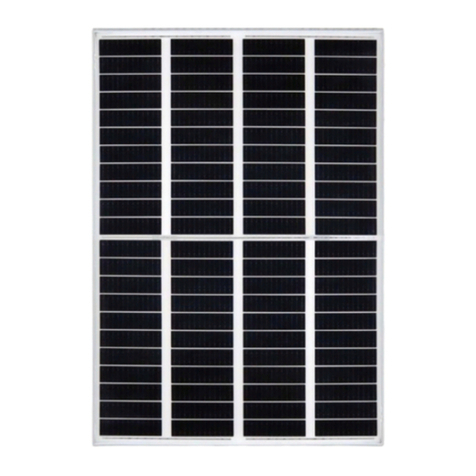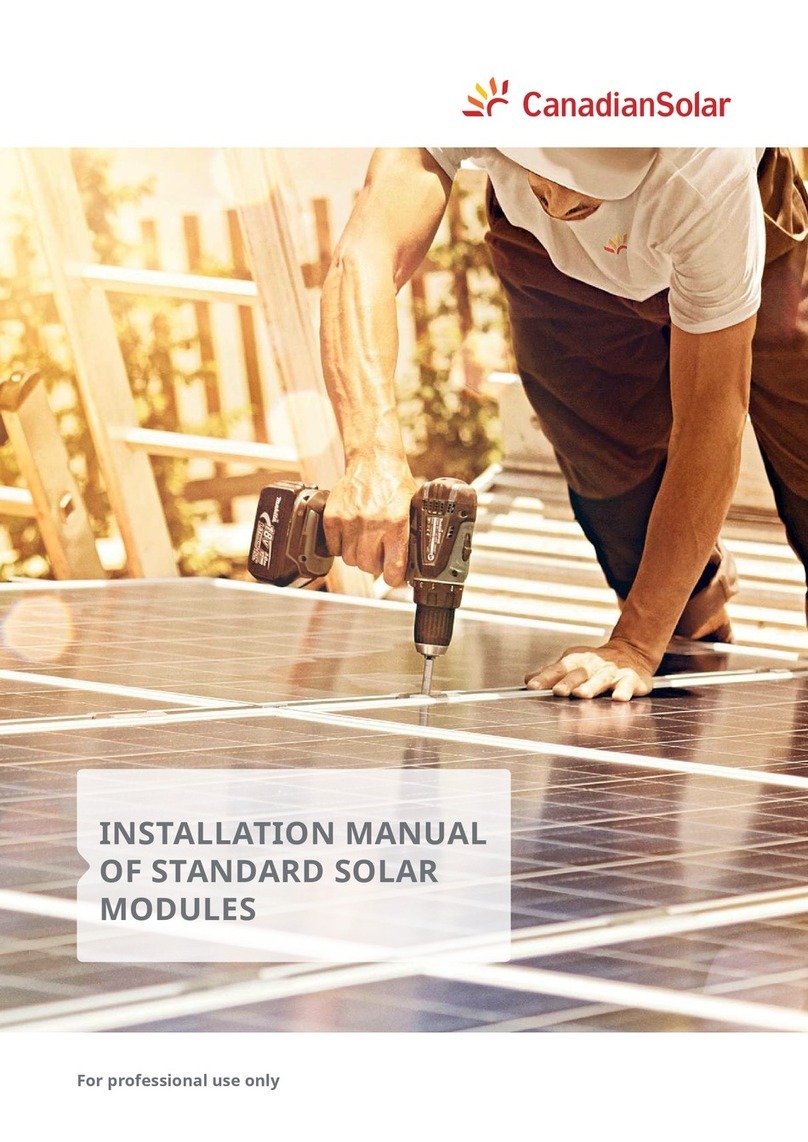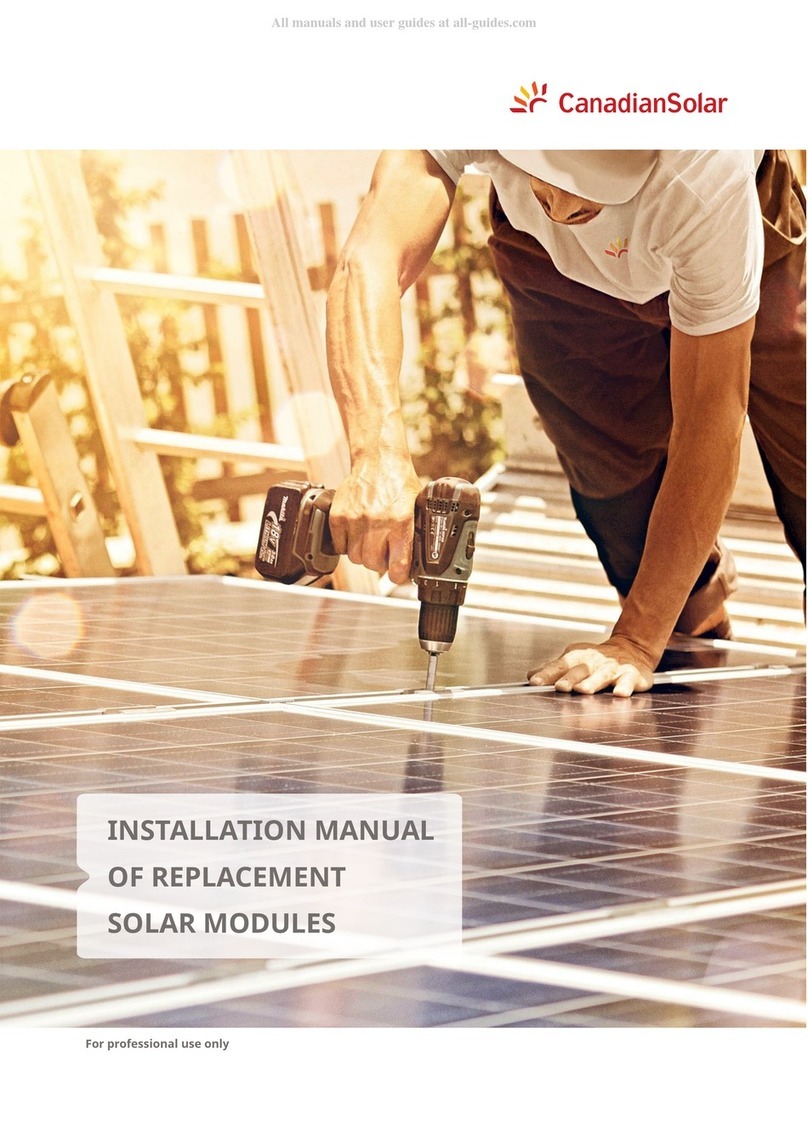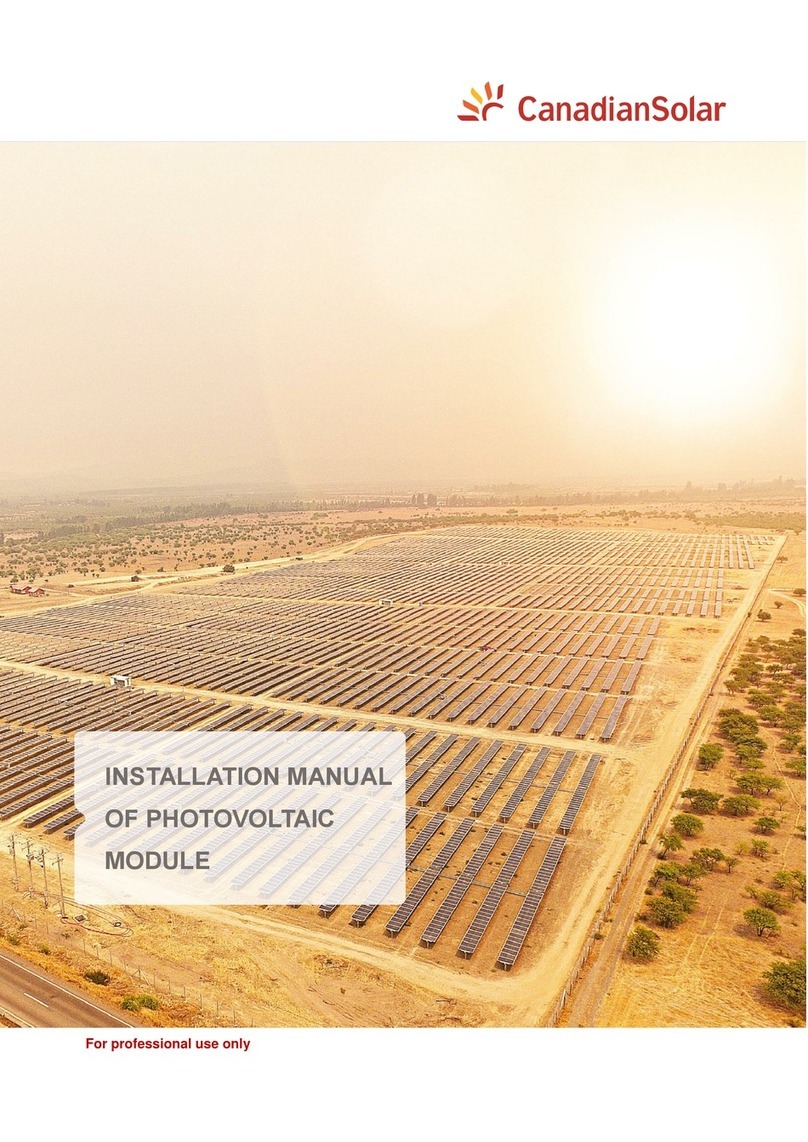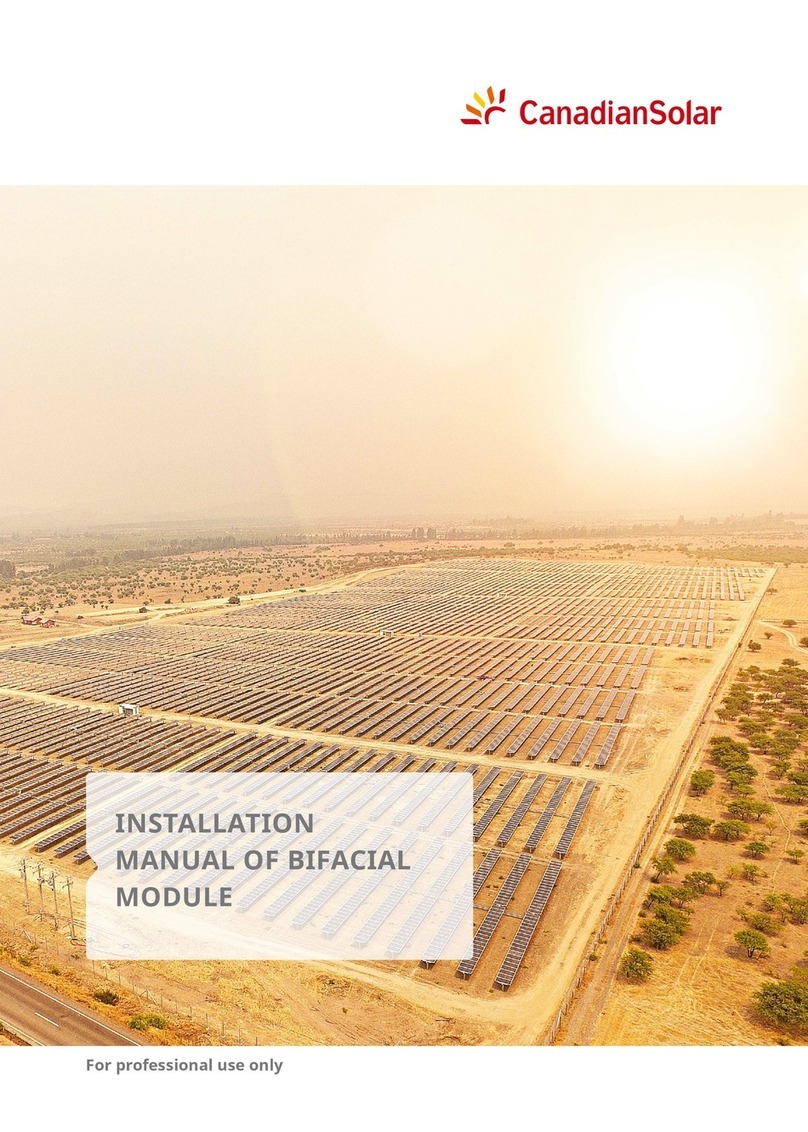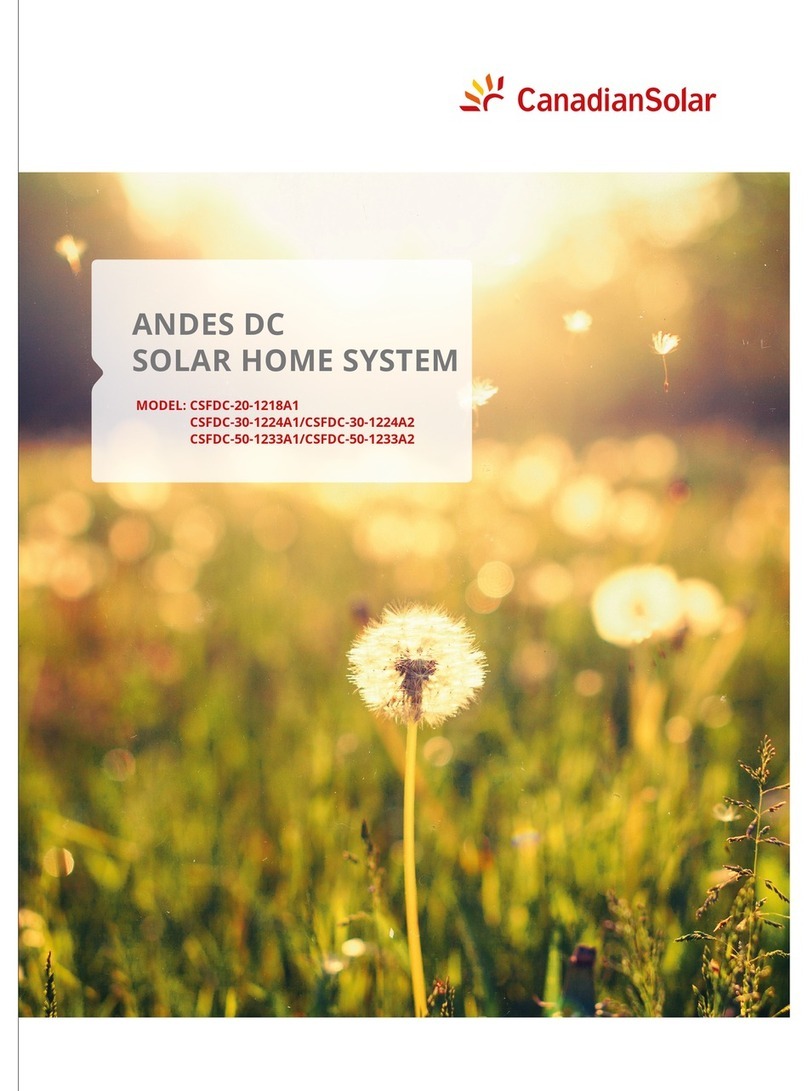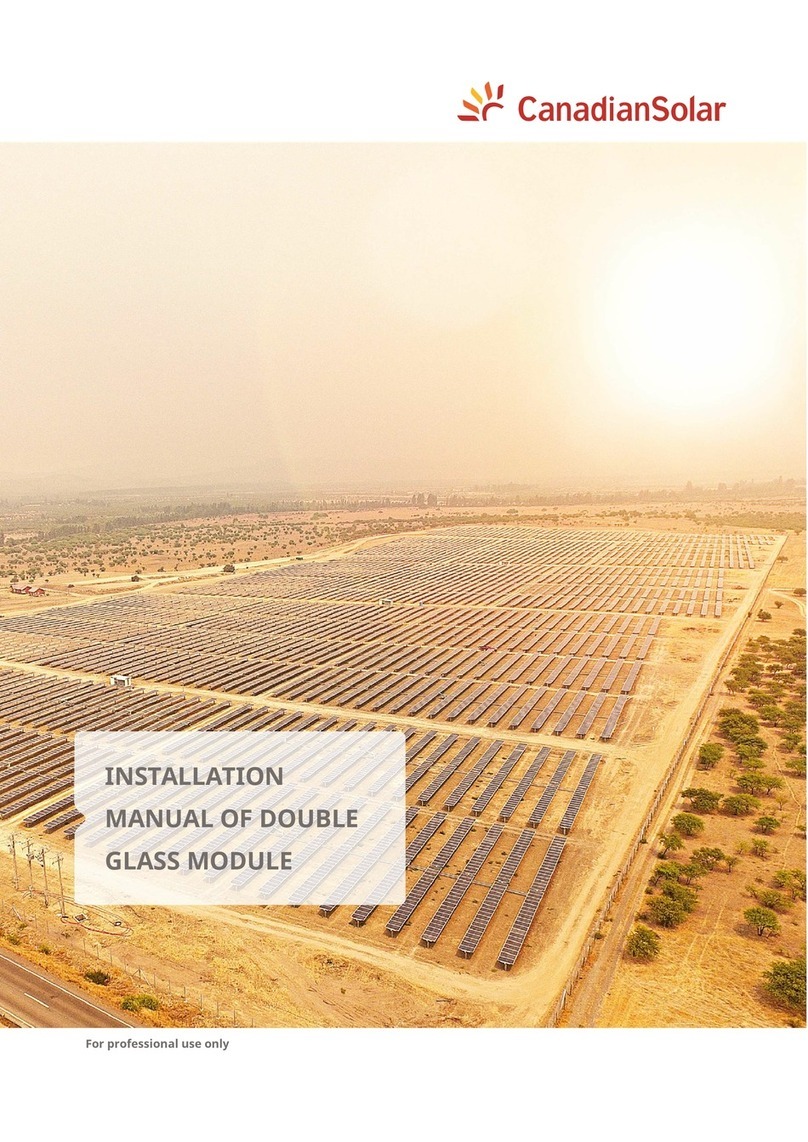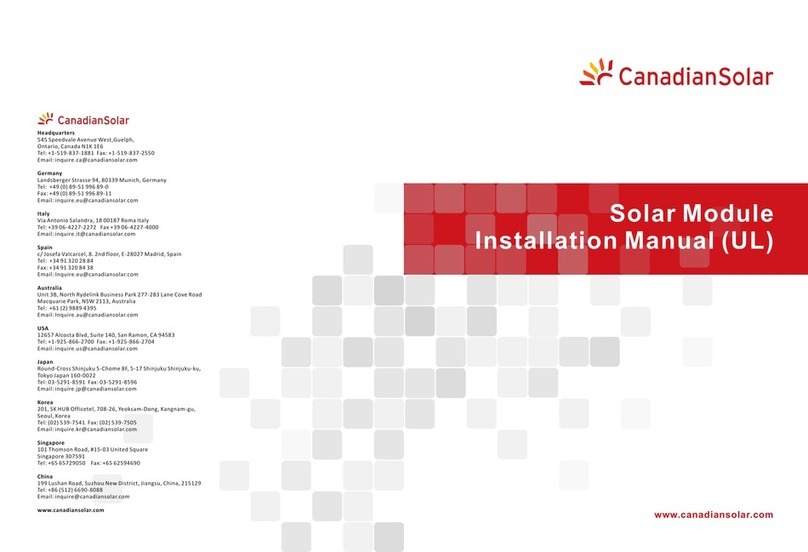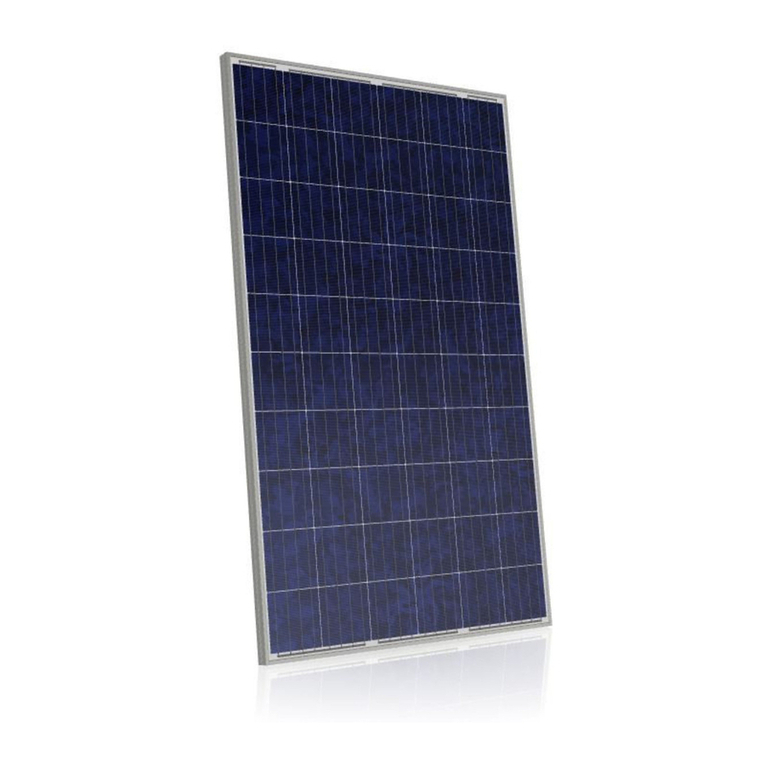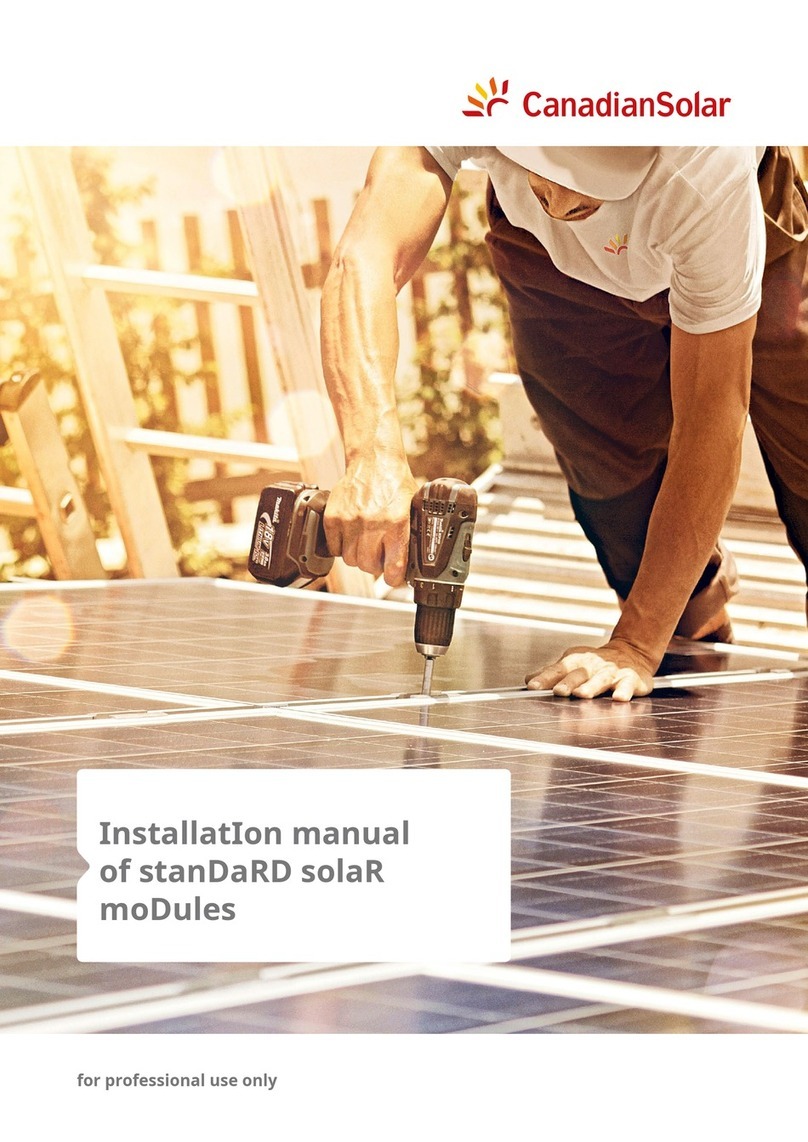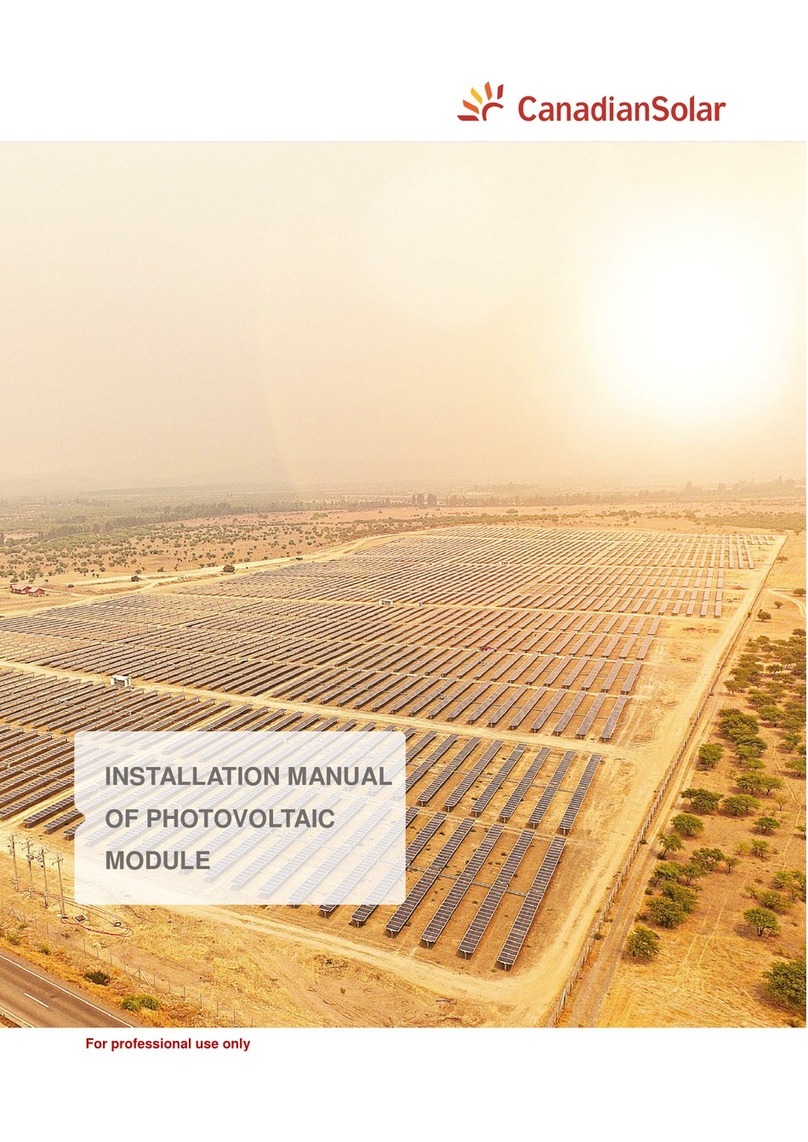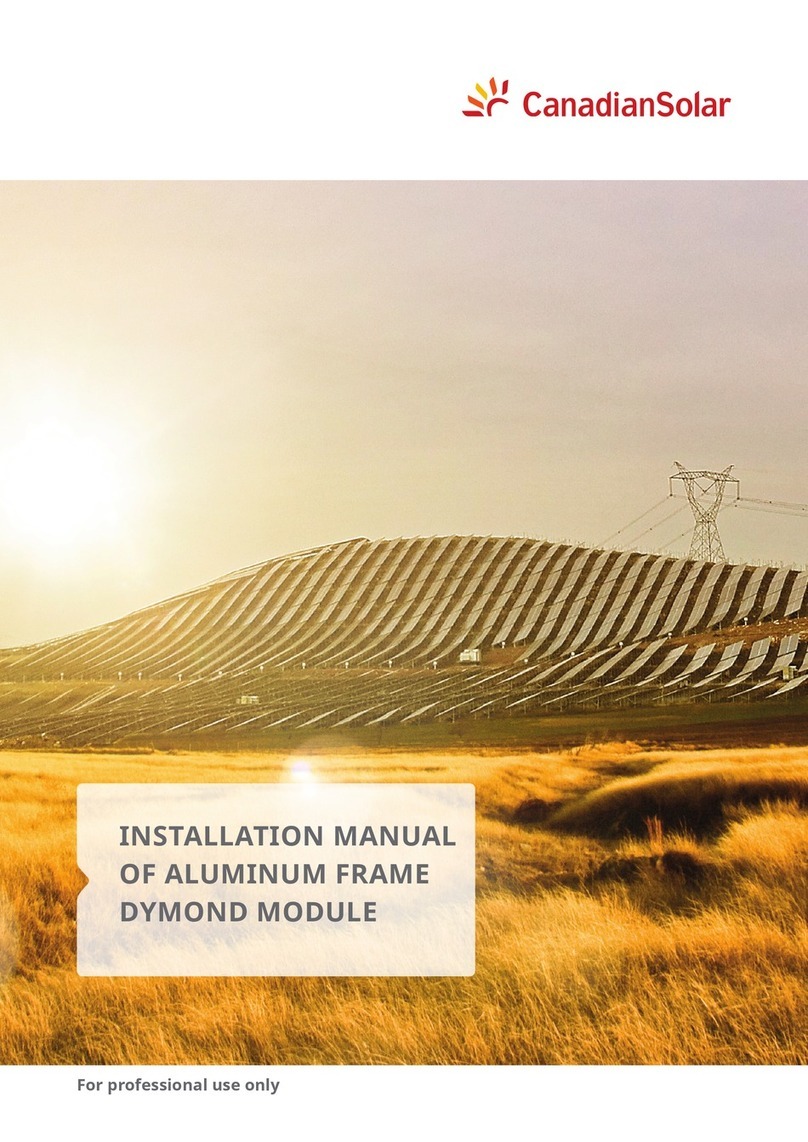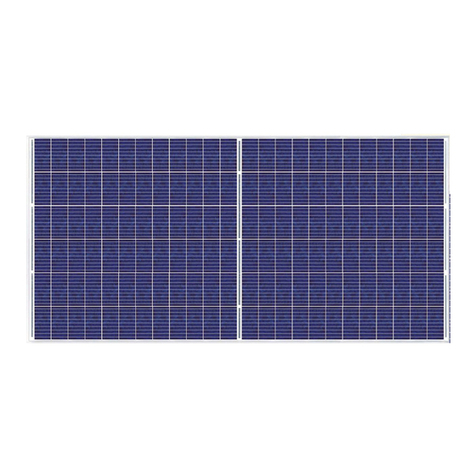
EN-Rev IM/UL-AM-EN/3.5 Copyright © June 2016. Canadian Solar Inc. www.canadiansolar.com
_Ɉ7Ɉ|
· The module is intended for use in general
RSHQDLUFOLPDWHVDVGHȴQHGLQ,(&
&ODVVLȴFDWLRQRIHQYLURQPHQWDOFRQGLWLRQV3DUW
Environmental conditions appearing in nature -
Temperature and humidity.
· Please consult the Canadian Solar Inc. technical
support department for more information on the
use of modules in special climates.
Do notLQVWDOOPRGXOHVQHDUQDNHGȵDPHV
RUȵDPPDEOHPDWHULDOV
Do not immerse modules in water or
constantly expose modules to water (either
fresh or salt) (i.e. from fountains, sea spray).
· Exposing modules to salt (i.e. marine environments)
or sulfur (i.e. sulfur sources, volcanoes) incurs the
risk of module corrosion.
· Failure to comply with these instructions will void
Canadian Solar Inc warranty.
INSTALLATION REQUIREMENTS
· Ensure that the module meets the general technical
system requirements.
· Ensure that other system components do not
damage the module mechanically or electrically.
· Modules can be wired in series to increase voltage
or in parallel to increase current. To connect
modules in series, connect the cables from the
positive terminal of one module to the negative
terminal of the next module. To connect in parallel,
connect the cables from the positive terminal of
one module to the positive terminal on the next
module.
· The quantity of bypass diodes in the module's
junction box may vary depending on the model
series.
· Only connect the quantity of modules that
corresponds to the voltage specifications of the
inverters used in the system. Modules must NOT
be connected together to create a voltage higher
than the maximum permitted system voltage, even
under the worst local temperature conditions.
· A maximum of two strings can be connected in
parallel without using over-current protection
device (fuses…) incorporated in series within each
string. Three of more strings can be connected in
parallel if an appropriate and certified over-current
protection device is installed in series with each
string.
· Only modules with similar electrical outputs
should be connected in the same string to avoid or
minimize mismatch effects in arrays.
· To minimize risk in the event of an indirect
lightning strike, avoid forming loops when
designing the system.
· The recommended maximum series fuse rating is
stated in a table in the Annex.
· Modules should be safely fixed to bear all expected
loads, including wind and snow loads. A minimum
clearance of 0.25 in (6.5 mm) or more between
modules is required to allow for thermal expansion
of the frames.
· The small drainage holes on the underside of the
module must not be blocked.
OPTIMUM ORIENTATION AND TILT
y 7RPD[LPL]H\RXUDQQXDO\LHOGȴQGRXWWKH
optimum orientation and tilt for PV modules in
your region. The highest yields are achieved
when sunlight shines perpendicularly onto the
PV modules.
AVOID SHADING
· Even minor partial shading (e.g. from dirt deposits)
reduces yields. A module can be considered to be
unshaded if its entire surface is free from shading
all year round. Sunlight should be able to reach the
module even on the shortest day of the year.
· Constant shading conditions can affect module
service lifetime, due to accelerated ageing of the
encapsulation material and thermal stress on the
bypass diodes.
RELIABLE VENTILATION
y 6XɚFLHQWFOHDUDQFHDWOHDVWLQFP
between the module frame and the mounting
surface is required to allow cooling air to circulate
around the back of the module. This also enables
for condensation or moisture to dissipate.
· Any other specific clearance required for
maintaining a system fire rating should prevail.
Detailed clearance requirements pertaining to
system fire ratings must be provided by your
racking supplier.
5.1
MODULE WIRING
CORRECT WIRING SCHEME
· Ensure that the wiring is correct before starting
up the system. If the measured open circuit
voltage (Voc) and short-circuit current (Isc)
differ substantially from the specifications, this
indicates that there is a wiring fault.
· When modules have been pre-installed but the
system has not been connected to the grid yet,
each module string should be kept under open-
circuit conditions and proper actions should be
taken to avoid dust and moisture penetration.
CORRECT CONNECTION OF PLUG CONNECTORS
· Make sure that connections are safe and tight.
Plug connector should not be subjected to stress
from the exterior. Connectors should only be used
to connect the circuit. They should never be used
to turn the circuit on and off.
· Connectors are not waterproof when unmated.
When installing modules, connector should be
connected to each other as soon as possible or
appropriate measures should be taken to avoid
moisture penetrating into the connector.
USE OF SUITABLE MATERIALS
· Only use dedicated solar cable and suitable plugs
(wiring should be sheathed in a sunlight-resistant
conduit or, if exposed, should be sunlight-resistant
itself ) that meet local fire, building and electrical
regulations. Please ensure that all wiring is in
perfect electrical and mechanical condition.
· Installers may only use single conductor cable
listed and labeled as USE-2 or PV Wire that is 90°C
wet rated with proper insulation that is able to
withstand the maximum possible system open-
circuit voltage. Only copper conductor material
should be used. Select a suitable conductor gauge
to minimize voltage drop and ensure that the
conductor ampacity complies with local regulations
(i.e. NEC 690.8(D)).
CABLE AND CONNECTOR PROTECTION
· Secure the cables to the mounting system using
UV-resistant cable ties. Protect exposed cables
from damage by taking appropriate precautions
(e.g. placing them inside a plastic conduit). Avoid
exposure to direct sunlight.
· A minimum bending radius of 2.36 in (60 mm) is
required when securing the junction box cables to
the racking system.
· Do not place connectors in locations where water
could easily accumulate.
5.2
EQUIPMENT GROUNDING
· A module with exposed conductive parts is only
considered to comply with UL1703 only when
it is electrically grounded in accordance with
both the instructions presented below and the
requirements of the National Electrical Code.
· Modules must be grounded, and module
installation must comply with all local electrical
codes and regulations.
· Grounding connections should be installed by a
TXDOLȴHGHOHFWULFLDQ
· Any grounding means used with Canadian Solar
,QFPRGXOHVVKRXOGEH157/FHUWLȴHGWR8/
and UL2703 standards. Please consult your sales
representative for formal approval process.
· Connect module frames together using suitable
grounding conductor. Holes provided for this
SXUSRVHDUHLGHQWLȴHGZLWKDJURXQGLQJV\PERO
· Use 6-12 AWG (4-14 mm2) copper wire only. All
EROWVQXWVȵDWZDVKHUVORFNZDVKHUVDQGRWKHU
